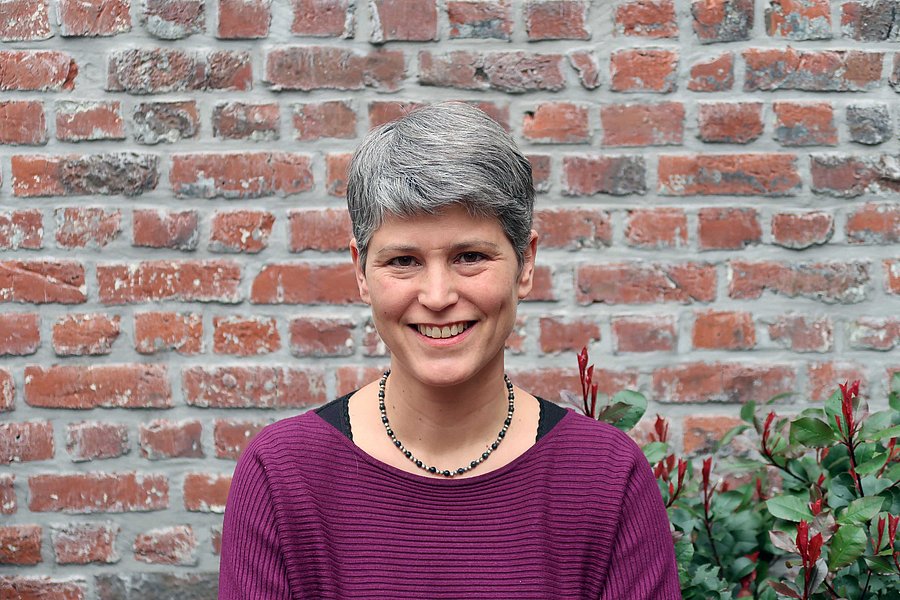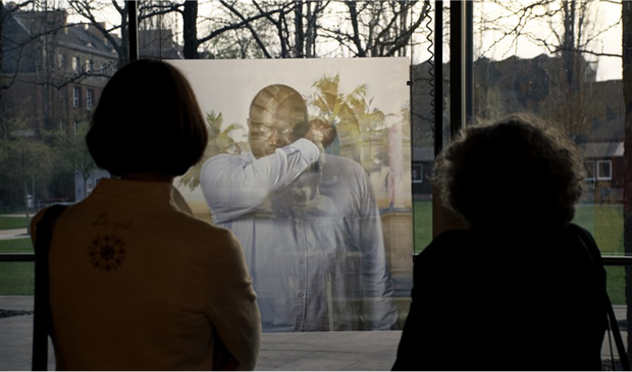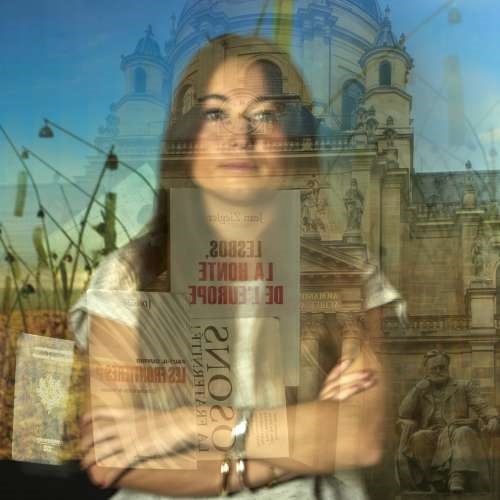
Scientists in Exile
Dr. Élise Julien / DAAD Visiting Professor
Photo: Private
The duty of solidarity
Dr. Élise Julien on the exhibition "Standing for Freedom" about scientists in exile, which is on display at Bergische Universität from April 3 to 29
Ms. Julien, starting April 3, an exhibition entitled "Standing for Freedom / Poser pour la liberté / Portraits of Researchers in Exile" will be on display in the foyer of Building K at Bergische Universität, which you are leading in Wuppertal. What is it about?
Julien: This exhibition traces the lives of researchers who were forced into exile through texts and images.
If freedom of science is restricted, this is an early warning signal for an endangered democracy. All over the world, scientists are threatened, censored, persecuted, dismissed, arrested, tortured and executed because of their research or their statements. Therefore, they are often forced to go into exile in order to be free, but also to continue making a scientific contribution. To find refuge, they depend on invitations from colleagues. These also appear in the exhibition. Thus, the exhibition spans a thematic arc from the history of scientific asylum to active solidarity.
How is the exhibition presented?
Julien: The exhibition offers a foray through four thematic areas: History of Science Asylum; Researchers in Danger of Their Lives; Science in Exile; Reporting, Observing, Witnessing. Each theme is introduced by an explanatory panel (French/English, German under QR code) and shows several portraits as transparent prints.
These portraits are photo compositions depicting the stories of each person. For the photographs, they were asked to bring four categories of objects of a symbolic nature: Photographs of their country of origin and host country, personal objects or those that refer to their field of research. The photographer has developed an apparatus with a mirror that makes it possible to superimpose all of this directly when taking the picture (i.e., without subsequent photomontage). By playing with transparency, the faces blend with the symbolic fragments, tracing the different paths of life. Sometimes they also disappear in order to maintain the anonymity of threatened scientists*.
Who conceived the exhibition and how difficult was it to put together the information?
Julien: This exhibition is the result of a collaboration between Pascale Laborier, professor of political science in Paris, and Pierre-Jérôme Adjedj, photographer in Berlin. It emerged from their dialogue on the representation of scientific exile.
Similar to Germany, where the Alexander von Humboldt Foundation and the German Federal Foreign Office launched the "Philipp Schwartz Initiative" in 2015 - with the help of which endangered scientists* can continue their work at German universities and research institutions - in France, the Ministry of Higher Education and Research launched the PAUSE program (Programme d'Accueil en Urgence des Scientifiques et Artistes en Exil i.e. "Program for the Emergency Reception of Scientists* and Artists* in Exile") to promote the reception of such vulnerable individuals in higher education, research or cultural institutions. Pascale Laborier was involved in the creation of this program.
In collaboration with the PAUSE program, Pascale Laborier and Pierre-Jérôme Adjedj are carrying out the RESTRICA project (Regards sur les Exils Scientifiques Contraints d'hier et d'aujourd'hui i.e. "Insights into forced scientific exile past and present"): Since December 2018, they have been meeting with researchers* who find themselves in a situation of forced exile to talk about their unique experiences. They contribute with images and words to make them visible and to testify what they have lost: Objects, places, a house, friends and colleagues.The exhibition, as we can see it today, opened in January 2021 at the "Cité du Design" in Saint-Étienne and is now on tour.

Exhibition Standing for Freedom:
Exhibit in the exhibition of the TU Dresden
As already mentioned, this is a traveling exhibition that will also be shown in other European countries. Around 40 scientists will be presented there. From which countries do the exiles come?
Julien: As part of the RESTRICA project, many people were interviewed and photographed, and others are still being interviewed and photographed. In the exhibition, 15 portraits are displayed in large format. In addition, there are three screens with cinematic presentations: one is dedicated to the animation of the 40 portraits, which were also published in a special issue of the magazine "Hommes & Migrations" with eyewitness accounts as well as other texts deepening the theme.
While most of the researchers at risk come from the Near and Middle East, more and more come from Africa, Asia and Latin America.
What threats have these researchers faced and continue to face in their countries of origin?
Julien: Some come from regions where the population has been displaced due to persecution, armed conflict, violence or human rights violations, for example Syria or Iraq. Others become targets of authoritarian regimes, such as artists, intellectuals or activists formerly in Chile or Uruguay, today in Turkey, Burundi or China. Others have to witness the destruction of their workplaces or homes in Xinjiang (China) or Aleppo (Syria). Whether in the Democratic Republic of Congo or Venezuela, all of them denounce serious human rights violations by oppressive regimes where there is no room for freedom of expression.
Which life story particularly impressed you?
Julien: This exhibition is very moving, each portrait brings a lot of emotion and reflection. Personally, I was particularly touched by the portraits that resonated in one way or another with my identity, whether personal or professional.
On the one hand, I was particularly struck by the story of Jean-Philippe Gunn, perhaps because, like him, I am a historian. This researcher fled the oppression he faced in Togo, however the dangers and threats to him have not disappeared in France. Knowing that colleagues we encounter daily in our universities have to live and work in constant fear should call us to a duty of solidarity. Jean-Philippe Gunn, moreover, reminds us of a fact too often overlooked: "No one chooses to go into exile for fun." In his portrait, his gaze is fixed directly on the camera and his right arm is raised over his left shoulder: It is not clear whether he is baring his face, wiping away a tear, or clenching his fist. This posture possibly reflects danger, pain, determination - or perhaps all at once.
On the other hand, I am sensitive to the story of people (there are a few here) who are committed to welcoming the exiles. In particular, this is the story of Amaryllis Quezada. She was born in France, where she was late to discover the extent of the atrocities of which her father was a victim during the Chilean military dictatorship. The latter had fled in 1977, earned a doctorate and became a professor of Spanish literature. Today, Amaryllis Quezada is involved in the PAUSE program to host researchers at risk. This young woman represents for me a kind of transmission: the transmission of a family memory made up of sufferings, but also of hopes, as well as the transmission of a democratic commitment that is expressed today in a return for what her father received as help at that time.

Exhibition Standing for Freedom:
Exhibit Amaryllis Quezada
You say that this exhibition "is an original format of political and cultural mediation" that will be accompanied by additional events to further raise awareness among scholars and civil society. What is planned?
Julien: At the beginning of this project, there was a reflection on what exile can mean when you go beyond the determination. As intermediate results, at the end of 2019, eighteen portraits were projected on a screen in Paris and musically accompanied by the ensemble "Orpheus XXI" composed of refugees; in 2020, a film was made and shown on the occasion of World Refugee Day; an Instagram campaign composed of eight portraits was also organized. As a (provisional) final result, the exhibition is in itself at the intersection of scientific research and art. It therefore offers an original format and the possibility of a multifaceted mediation on the theme of exile.
At our ceremonial opening on April 11, we will expand the perspectives: the political-scientific view of the curator, the artistic view of the photographer, the view from the experiential world of a refugee colleague from Ukraine. The event will be enriched by a musical contribution: The duo "Marion & Sobo", with French-American and Polish roots founded in Germany, mixes languages and cultures in a style that combines chanson and global music. This is another way of understanding and feeling exile, between nostalgia and hope. Finally, there will be a panel discussion with participants from different disciplines (literature, history, political science, sociology) to provide scientific analysis on exile. There will be something for everyone!
How long will the exhibition be on display at Bergische Universität?
Julien: The exhibition will be on display from April 3 to April 29 in Building K at Bergische Universität (Grifflenberg Campus). It is barrier-free and freely accessible: everyone is welcome! On April 11, starting at 4:00 p.m., the festive opening will also offer the opportunity for a varied program as well as a guided tour of the exhibition.
More about the exhibition: https://www.romanistik.uni-wuppertal.de/de/personal/literaturwissenschaft/dr-elise-julien/dr-elise-julien/ausstellung/
Uwe Blass
Dr. Élise Julien has been a visiting lecturer at Bergische Universität Wuppertal since October 2021. In Romance Studies, she supports in particular the bi-national course "Applied Cultural and Economic Studies: German-French". The scholar comes from the Grande École Institut d'études politiques de Lille. The lectureship is funded by the German Academic Exchange Service (DAAD).
